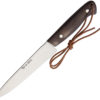I noticed today there is an error in the conversion from centimetres to inches in Domenech's essay in his first reference to Verijeros.
I grew up with the metric system and still find it hard at times to visualize or convert to the imperial system.
He states in
Photo 1:
"A group of puñales and verijeros. The difference in name relates to the length of the blade which, in turn, conditioned the place of carrying.
Verijeros usually have a blade of 13 to 15 cm (around 7 to 8 inches)"
A 13 to 15 centimeter blade would correspond to approximately 5 to 6 inches for Verijeros
not 7 to 8 inches (or 8 to 9 inches as in quote above)
So far, the general consensus that I have encountered seems generally in line with this; Verijeros being less than 15 cm and puñales above that
.
My two Verijeros have a blade of about 12 cm.
Domenech mentions the Verijeros again later in his essay and is consistent in describing them as knives (or cuchillos) with blades of not more than 13 to 15 centimeters in length.
"Smaller knives, with blades of not more than 13 or 15 cm and with metal or wooden handles, a smaller version of puñales, are usually carried on the front and are called verijeros. This name of verijero comes from the carry position, on the front near the right side of the belt buckle (rastra) and near the groins, a part of the body popularly known locally as verijas. Argentineans remain fond of owning a little verijero, silver handled, sometimes with silver sheath, and making it proudly shine at a Sunday barbecue (asado). Its 13 to 15 cm blade makes a very practical cutting tool indeed."
Today I got curios to see how the blade of my Pampa Verijero was held in place inside its sheath.
I was able to gently pull put out two curved thin pieces of metal from inside the sheath.
After a quick wipe back in there they went
























